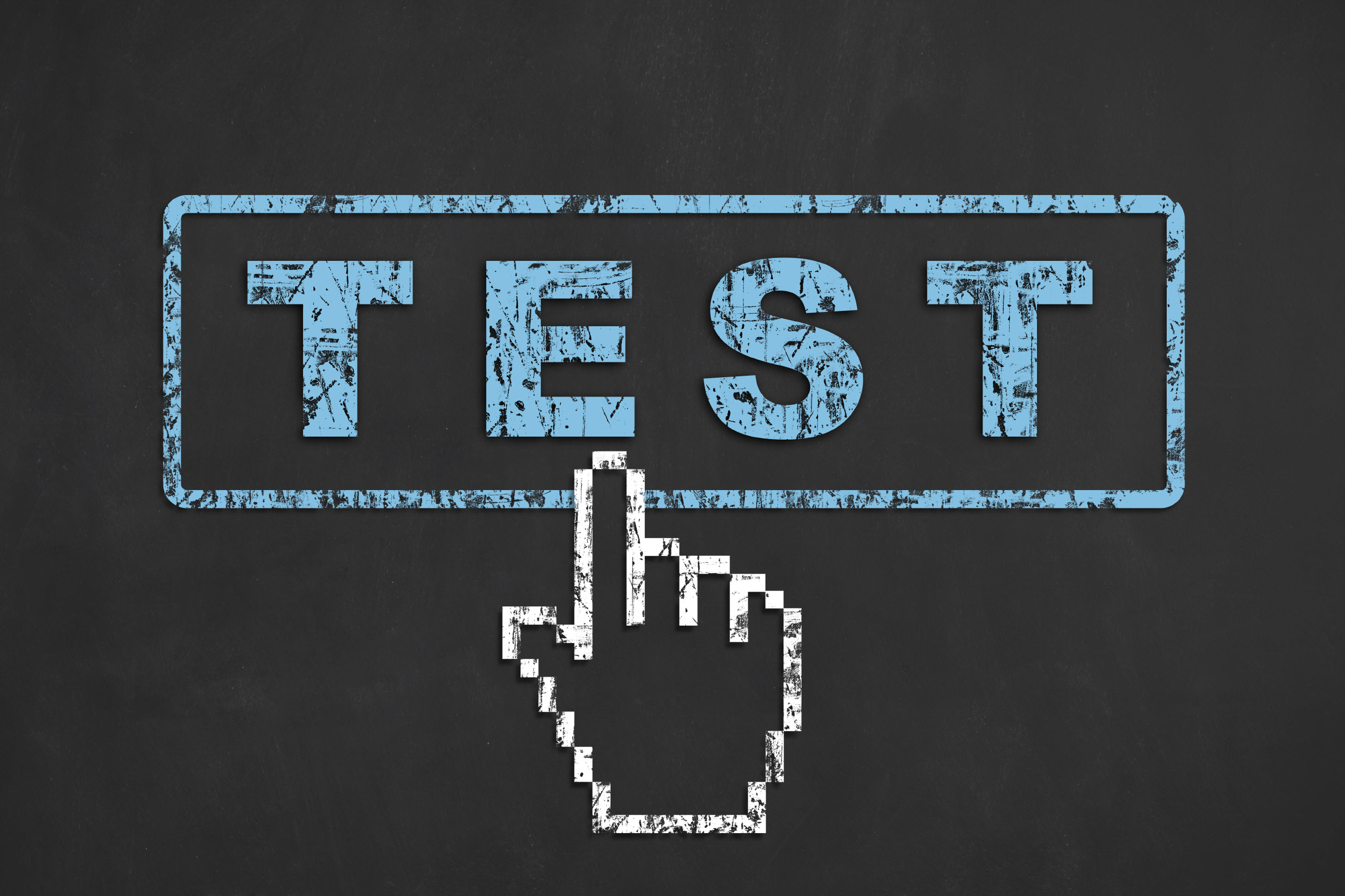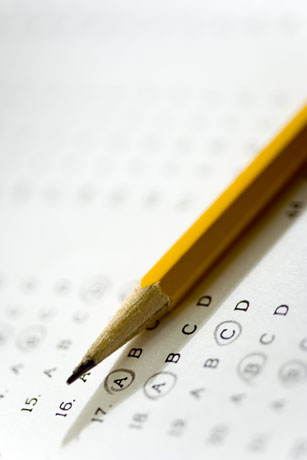 Each spring, millions of publicly educated students around the country buckle down to a yearly tradition — standardized tests.
Each spring, millions of publicly educated students around the country buckle down to a yearly tradition — standardized tests.
In theory, standardized tests are designed to objectively measure a student's knowledge and produce a score that compares that student to all the others who took the same test. These tests are supposed to measure how well students are being educated and identify areas where students are excelling and falling behind.
These methods are not new. Standardized tests date back decades in the United States. Most of us know about the SAT and ACT, high-stake assessments that colleges consider for admittance. Even elementary students were subjected to days of filling in tiny bubbles on a score sheet.
The whole idea of standardized testing has long been controversial, but this year the new Smarter Balanced Assessment has set the country's educational community on fire.
The implementation of Smarter Balanced is a tale of politics and protestors, federal funds and significant money to be made by the companies who develop the tests.
The subplot, and the question some parents and educators have been asking even as testing is scheduled and conducted (and as some families have opted out), is whether such tests are really necessary in the first place.
The test
The Smarter Balanced Assessment is a computer-adaptive test being given to students in grades 3 through 8, and grades 10 and 11, in about 18 states this spring.
This test was created to measure the Common Core Standards ― benchmarks in math and English language arts/literacy that are intended to create consistent expectations of knowledge across the country.
The tests are given via computer, and the test program "adapts" to each student based on the student's responses — meaning the program adjusts the difficulty of questions throughout the assessment. This also means that different students will see different questions.
Students will get a score of 1, 2, 3 or 4. A score of 1 is considered not proficient, 2 is approaching standards, and 3 and 4 means the student is at or above the standard.
"It is intended to give a more realistic picture of the students' actual skills," says Kristen Jaudon, communications specialist for Washington state’s Office of Superintendent of Public Instruction (OSPI).
Jaudon refers to the Smarter Balanced website, which explains that the adaptive testing is designed to give a more complete picture of a student's knowledge. If a student's answers indicate that she is clearly above or below the grade level expectation, the computer will adapt the questions accordingly.
An important point, Jaudon explains, is that students get several chances to prove they understand a concept. Once the student demonstrates he meets a standard, he can then move on. If the student's responses show he is doesn't understand a standard after several attempts, the student will be given less difficult questions.
"The overarching philosophy is to pinpoint where they are and where they aren't," Jaudon says.
What are the stakes?
According to OSPI, students in third through eighth grades are taking the Smarter Balanced Assessment to determine a school’s "adequate yearly progress" status, which measures states, schools and districts by the results of state-level tests.
The results are also being used to identify third graders who are not proficient in English/Language Arts (ELA). A Washington state law passed two years ago requires a literacy plan be created for children with a level 1 score in the ELA portion of the test, according to Jaudon.
Sophomores are taking the Smarter Balanced test for English Language/Arts this spring. For this class, the Washington State Board of Education will set an "exit exam cut score" that must be met in order for students to be allowed to graduate from high school. That score will be determined in August. Sophomores who pass will not have to retake the Smarter Balanced test as juniors.
Additionally, there is legislation currently being considered that would tie test scores to teacher assessments, according to Nathan Olson, communication manager for OSPI.
This legislation is in response to a mandate by No Child Left Behind. Many states received waivers allowing them to not have to meet this mandate. The waiver allows for schools to have access to $40 million in federal funds, without proving each year that a state has met adequate yearly progress in reading and math. Adequate yearly progress is a provision in No Child Left Behind that requires an increasing percentage of students to pass state tests in reading and math each year, Olson says.
Part of this waiver states that one component of the teacher evaluations must be tied to standardized tests, Olson says.
Washington is the first and only state to lose its waiver.
Tying teacher assessments to standardized test results is also part of the requirement to regain that waiver.
While Superintendent Randy Dorn supports state test results as part of teacher assessments, he feels it should be only one of several measures of teacher performance, Olson says.
About 60 percent of students are expected to be scored "not proficient."
Jaudon says this high rate is normal when a new test is administered. Proficiency rates typically rise over the years, she says.
There is no consequence for a student if they chose to opt-out. However, next year the juniors will need to either take the Smarter Balanced test to graduate from high school, or take another similar assessment.
Responding to growing numbers of students opting out around the nation, U.S. Education Secretary Arne Duncan, who has argued that standardized testing is essential for measuring student progress, said last week that the federal government will have to intervene if states fail to address the opt-outs, according to Chalkbeat.
 The controversy
The controversy
While standardized testing has its critics, the uproar over the implementation of the Smarter Balanced Assessment is without precedent.
"We are actively witnessing more opt-outs of standardized testing than at any other point in the history of the Seattle school district," says Carolyn Leith, a parent of a third-grader at Olympic View Elementary and a leader in the Seattle Opt Out Group.
The number of Seattle Public Schools student opting out of the test continues to grow. About 150 to 200 juniors at Roosevelt and Ingraham high schools are opting out of the Smarter Balanced test, which is about half of the junior classes. All of the 11th grade students at Nathan Hale have opted out of taking test.
In Tacoma, about 67 students have officially opted out, but that doesn’t mean everyone is taking the test. Unofficially, some students just don’t show up for the test.
In order for this test to be valid, a school must have a 95 percent participation rate. Schools without that rate are not showing "adequate yearly progress," which is required by law. Schools not showing progress must send letters home to parents stating that the school is not meeting proficiency.
Several groups around the state and country are opposing the testing, including both parents and teachers.
Kim Golding, founder of Parents and Friends for Tacoma Public Schools, supports opting out of the test.
"We feel like testing is helpful if the results mean something to the teachers and they get them in a timely fashion," she says.
As it currently stands, the results won't be available until the summer.
"We place a lot of trust in teachers," Golding says. "We don't believe the schools are failing our students."
Smarter Balanced test resisters cite time-consuming technical glitches, unnecessary stress on the students, excess amounts of time "wasted" administering the test, and bias against poor and minority students.
About a dozen concerned teachers, parents and community members held a press conference at the NAACP office in early April. The group laid out several examples of why members consider this a testing debacle.
One class in the Seattle Public Schools reportedly spent six hours taking the first half of the test, only to find out that the directions received from the district had been incorrect. The students had to retest.
Meg Richman, a language arts teacher at Franklin High School, shared that a high-achieving Vietnamese student was brought to tears over her inability to finish the test due to the language barrier.
"She asked for a translator, and I had to tell her that she can't have one," Richman says. "This girl is so studious that she would put the rest of us to shame. She wants to be a doctor."
Eighty-five percent of students in Richman's first-period class speak a language other than English at home. While there is a translation glossary on the test, it leaves out African languages, which many of Richman's students speak.
Doug Edelstein, a history teacher at Nathan Hale, considers resisting this test a matter of social conscious and justice.
"Is this a fair test?" Edelstein asks. "The answer is, it is not."
The argument in favor of standardized tests
Maggie Morgan, assistant dean for the School of Graduate Education at the online Kaplan University, supports the idea of standardized tests.
"At the core is the issue that we need to measure student proficiency," she says. "There needs to be some kind of standard."
Morgan is a former teacher and military mom. Through her experience, she found that children who move around often find themselves either ahead or lagging behind when they start at a new school, an experience which highlights the inconsistencies from state to state.
She recalls a girl who moved from Louisiana to Joint Base Lewis-McChord. In Louisiana she was a high-achieving student. In Washington state she was behind her peers.
"In Washington, there was a very different set of standards," Morgan says.
While Morgan believes there needs to be consistent standards, she also believes that tests need to be fair, be informed by and address social justice issues, and be designed by the appropriate bodies. She acknowledges that the issue of tying test scores to teacher evaluations has fueled the national backlash against testing.
Jesse Hagopian, a history teacher and Black Student Union advisor at Garfield High School in Seattle, believes there are better ways of assessing students. He refers to a more comprehensive assessment, like the one used in New York City.
"We need to replace these tests with truly authentic measures," he says. "We have made a grave error. We are training our students tat wisdom is the ability to eliminate a wrong answer or a choice, rather than to think critically, to question, to imagine, to collaborate, to identify a problem in your community and solve it."
"That should be what our schools are about," Hagopian says.
Scheduled testing will continue through the spring. However, Smarter Balanced Assessment’s long-term prognosis is cloudy.
Several forces are at play. A growing defiance of parents opting out, proposed legislation that could change No Child Left Behind, and a threat that the federal government could intervene means that all long-term bets are off when it comes to Smarter Balanced Assessment’s future.











